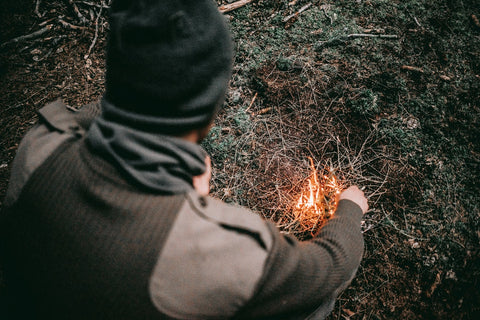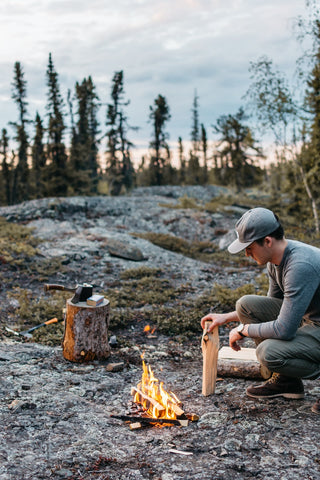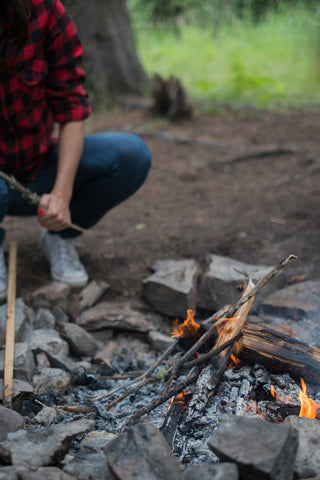A Foolproof Technique for Fire Starters
You can start a fire easily with a variety of household objects like matches, cloth, cotton balls, or a small lighter. However, in the wilderness, it’s always good to have flint and steel by your side.
Here’s how to start a fire using flint and steel:
1) Make a Tinder Bundle
A tinder bundle is also known as a “bird’s nest,” and you can use a variety of organic materials to light it up. Just make sure that the materials are dry. You can use a combination of:
- Bark from trees such as birch, cottonwood, cedar, or tulip poplar trees
- Dried leaves and dead grasses
- Wood shavings
- Small twigs that are up to half-an-inch in diameter
- Cotton balls

Try and compile this nest together in a small, circular bundle that you can use, together with your char cloth, to capture the sparks and light the first part of the flame. You can also set this nest down into an existing fire-ring or firepit.
2) Using a Char Cloth
To capture the first sparks of steel against flint, outdoor survivalists will use charred cloth. Cut three or four pieces of linen or cotton cloth and make sure these sit right next to the flint’s sharp edge. Measure these pieces to be about three square inches and make sure the edges are fluffed out so they can capture flying sparks. Once you have a char cloth that is sufficiently heated by the sparks, place it within the bird’s nest or tinder bundle.
3) Strike Your Flint and Steel
There’s a trick to striking the flint against the steel. You may think that it’s about striking the flint hard, but, rather, the sparks cast depend on the speed of the steel. And because speed is at play, you may tend to run a short-stroke, but this won’t work. Instead, use a long stroke.
Pro-Tip: Practice doing a long stroke before you’re good and ready to strike. To strike a long stroke, bend your arm at the elbow and accelerate the steel through at least a foot of space before contacting the flint. Make sure to angle the flint upwards, toward the steel.
The more you use flint and steel to start a fire, the easier you’ll be able to strike a spark with precision. Done right, you should be able to hear the sparks fizzing as they fly, as this is evidence of a strong, firm, and successful stroke. The char cloth should smoke, or char, and it’s at this point that you can drop your steel and flint and quickly transfer the char cloth to the bird’s nest.
4) Feed the Fire
Drop the charred cloth in the center of the nest and cup it to protect the fledgling sparks and embers from going out. At this point, you can gently blow with a long, strong breath. Avoid short, staccato blasts of breath as this may just put the nascent sparks out.

If you’re doing it right, your bird’s nest and char cloth will start to smoke. Give your firestarters a minute or two to catch on, and you’ll have small but hearty flames in no time! Once the flames grow, feed the fire with kindling (small, dry sticks and longer pieces of bark), then once those are lit add small logs. You’ve just created your best survival tool from flint and steel!
Following these steps will get you a fire in the wilderness, but being extra prepared will help your chances (especially in less favorable conditions). With that in mind, we want to share a few additional preparation tips and techniques.
Preparation for Starting a Fire
Of the handful of ways to start a fire, learning to do so without a match or lighter is not just an impressive skill, it’s a matter of survival. Besides prepping the flint you’ll use, you should also prep the site you’ll be using to tend your fire.
To create your own firepit, start by clearing away any grass or other combustible materials. Get down to bare dirt, dig just a few inches below, and then place your tinder bundle within. Mound the extra dirt around the edges to create a protective barrier.

Now you can start adding more strategic rocks and wood pieces to help you reflect the embers, protect them from the wind, and feed the fast-growing fire.
Why Flint and Steel Are the Most Reliable Materials
Preparation for the fire you’re about to build also involves preparing your flint piece or flint rod and steel. Flint rods, for example, are inexpensive and common outdoor accessories that you can find at any outdoor supplier. These rods, however, are made from magnesium or iron oxide, not flint.
If you don’t want to buy a flint rod, you can always rely on natural flint “deposits” around the area. It really depends on where you’re camping or trying to set up a fire. Niagara chert, for example, works well if you can find it in the area. Other useful rocks that you can work with include:
- Quartz
- Agate
- Carnelian
- Jade
- Bloodstone
- Chalcedony
The ideal flint for striking up a fire should have a sharp, acute edge that takes a bite out for the steel. Many people think that the flint gives off sparks, but it’s the sharp edge of the flint that carves off a small slice of the steel, which then sparks.
The good news is that you can use the sharp edge of your steel to “knap” the flint. Knapping is the art of sharpening the edge of your flint rock until it’s sharp enough to take a bite out of the steel. To do this, you can use a camping knife, or you can use your steel as well. If you plan to get strong sparks at the first strike, avoid using flint with a rounded or blunt edge.
Conclusion
Starting a fire using flint and steel is very impressive and a useful outdoor survival skill to have. The best part about it is that you don’t need to carry too many extra supplies.
At Self Reliance Outfitters, we carry a range of flint and steel kits, including traditional “C” shaped steel strikers, iron pyrite, and char cloth materials. Ultimate survival and outdoor enthusiasts can learn how to use these crucial tools, and more, through our quintessential Bushcraft 101 workshop.
Rely on your own wits, skills, and Self Reliance Outfitters to get you through the challenges of the outdoors. Rely on Self Reliance Outfitters and get the gear you need for less!




